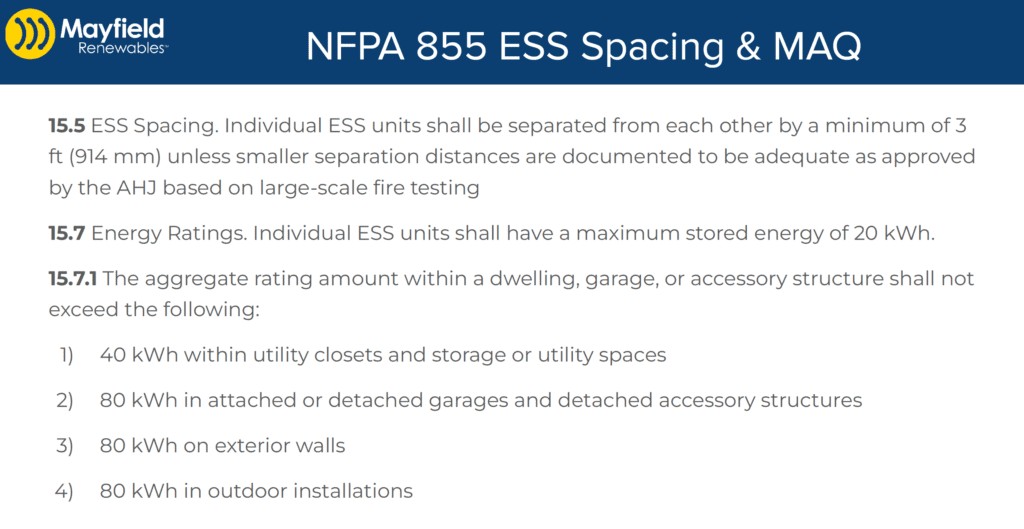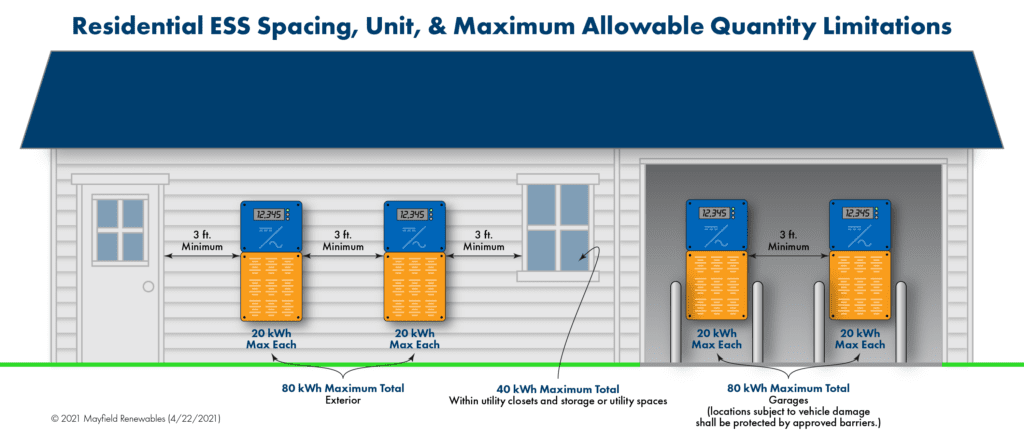Code Corner: NFPA 855 ESS Unit Spacing Limitations

In this edition of Code Corner, we’re talking about NFPA 855, Standard for the Installation of Stationary Energy Storage Systems. Specifically, we’re focused on spacing requirements and limitations for energy storage systems (ESS). NFPA 855 sets the rules in residential settings for each energy storage unit—how many kWh you can have per unit and the spacing requirements between those units. First, let’s start with the language, and then we’ll explain what this means. In Section 15.5 of NFPA 855, we learn that individual ESS units shall be separated from each other by a minimum of three feet unless smaller separation distances are documented to be adequate and approved by the authority having jurisdiction (AHJ) based on large-scale fire testing.
Therefore, if you install multiple storage units, you have to space them three feet apart unless the manufacturer has already done large-scale fire testing and can prove closer spacing will not cause fire to propagate between adjacent units. The required testing is part of the UL 9540A test method, Test Method For Evaluating Thermal Runaway Fire Propagation In Battery Energy Storage Systems. As part of these testing methods, a determination is made about the fire risk associated with individual units installed near each other.
If the test results in an appropriate level of risk, the manufacturer will document the minimum required separation between multiple units in the installation manual. If the manufacturer cannot produce the desired results of the 9540A test, adjacent units must maintain at least 3 feet of separation to mitigate the risk of fire propagation between units.
Another important topic is the energy rating of individual units. Individual ESS units shall have a maximum stored energy of 20 kWh per NFPA Section 15.7. NFPA 855 clearly tells us each unit can be up to 20 kWh, but how much overall storage can you put in your installation? That depends on where you put it and is defined in Section 15.7.1 of NFPA 855. You can have up to 40 kWh within a storage or utility space inside the home. For an attached or detached garage or a detached accessory structure, you can go up to 80 kWh. Outdoor installations, including those on exterior walls, can go up to 80 kWh. See the illustration below for a visual example of these capacity restrictions.

The diagram shows that each ESS unit can have a maximum rating of 20 kWh, and if you’re going to install two units, let’s say outside on your wall, you need to have the appropriate spacing between those units and three-feet separation from doors and windows per NFPA 855 15.6.1. The diagram also shows that if you’re inside the home, you can go up to 40 kWh; if you’re outside the home on the wall, you can go up to 80 kWh; and if you’re in a garage, you could also have 80 kWh there. All locations will require multiple units to reach the 40/80 kWh limit, which is fine as long as they’re adequately spaced per this code.
Many customers want to know if they can really only have 80 kWh total for their residential installation. That question is up for debate. Recent language released by the California fire marshal is a bit more lenient on that and indicates it might be okay if you have 80 kWh in the garage, 80 kWh outside, and another 40 kWh inside. However, you shouldn’t assume that’s the case everywhere because different AHJs might interpret the rules differently. Others might say 80 kWh entirely for your installation, or they might realize that these are different fire areas and they’re okay with having, for example, 80 kWh outside and another 80 kWh in a garage, as long as you don’t go over those kWh limitations per location.
If you’re looking to dive deeper into fire codes for energy storage, you’re in the right place! At Mayfield Renewables, we offer design and engineering services for ESS systems as well as educational courses such as live and recorded sessions on energy storage codes and the National Electrical Code.










